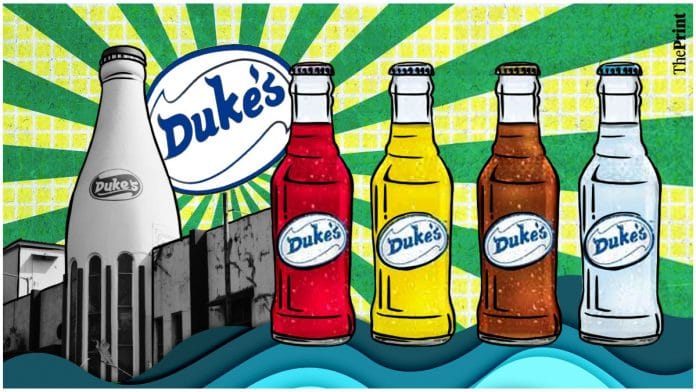New Delhi: Glass soda bottles are pure nostalgia. A visit to the neighbourhood grocery store with its bright-coloured bottles lining the shelves can bring a rush of memories.
Duke and Sons’ soft drinks, with their distinct flavours of tango, lemonade, raspberry, ginger and pineapple, have been an inevitable part of Indian households — from Sunday family rituals to celebrations.
And the person who introduced these to the market was teacher-cum-cricketer Dinshawji Cooverji Pandole, whose son Dinshaw Pandole died last week.
Dinshawji Pandole came up with the idea of starting a bottled soft-drink company during one of his tours to England. He established Duke and Sons in 1889, one of India’s oldest soft drink companies, and named it after the brand of cricket ball he used during the England tour with a Parsi team.
With some other Parsi soda enterprises already in the market at the time, Duke and Sons did face competition. But that didn’t seem to faze the Pandole family. They brought to India a never-before-seen line of products that took the country by storm with their psychedelic colours — and for good reason.
Also read: ‘Kya aapke toothpaste mein namak hai?’ — Colgate ad that gave one of the most recalled taglines
Duke’s sodas
Pandole’s Duke & Sons offered a wide range of sodas to the dull shelves of the Indian market.
Their Gingerade was the cure-all for anything related to the stomach. Then the electric red raspberry soda was a favourite among all ages — a sweet, carbonated drink that was a staple in parties and wedding celebrations. Another fan favourite was their Lemonade.
The sodas had a cult-like following among Mumbai’s Parsi community and mill workers alike. There was a novelty around Duke’s sodas that really allowed them to flourish. Each of the flavours brought with a certain vibe, allowing the sodas to melt seamlessly into any and all occasions.
Even as larger beverage corporations entered India, Duke’s sodas survived for a while and continue to grow. In the 1950s Coca-Cola launched in India, giving Duke and Sons a run for their money. Both brands were competing for the same shelves and it was around this time that Pandole pulled out a trick from his sleeves that no one saw coming.
Also read: Fuss over Ranveer Singh’s nude photos isn’t a first, Milind Soman-Madhu Sapre ad is a reminder
Mangola
Before there were brands like Frooti, Slice or Maaza, there was a tremendously popular mango fruit juice drink called Mangola, brought by Duke and Sons in the 1950s. A thick, golden juice with an almost syrupy consistency, Mangola was made of real fruit pulp and brought the joy of seasonal mangoes throughout the year.
Mangola was introduced to the Indian market as a competitor to aerated cola drinks. Pandole realised that the only way to keep up with the onslaught of competition was to diversify their products.
The mastermind behind Mangola was Feroze Pandole, Dinshawji Pandole’s other son.
“He (Feroze) went to a food canning factory and asked them to make 3,000 cans of mango pulp. He then prepared his own formulation. What he also did was sell it at the price of an aerated drink. So people were getting a 100 per cent fruit-based drink for the price of a lemonade. It was a blitzkrieg,” Feroze’s son, Naval Palonde said in a 2018 interview.
Mangola was the first non-aerated drink to come from Duke’s banner — it was more of a juice and less of a cold drink. This experimentation proved to be immensely successful for the brand, as it turned the tables on the big corporations.
They also barely spent anything on advertising because the product spoke for itself. One found Mangola everywhere — kirana stores, schools, hotels and railway stations.
Also read: Favre-Leuba — ‘first’ Swiss watches to hit Indian market ran out of time in smartphone era
The end?
Unfortunately, Mangola wasn’t enough. In 1995, Duke and Sons was bought by PepsiCo. At this time, the company had held a market share of 55 per cent in Mumbai. The Pandole family manufactured Duke’s original host of drinks till 2004, after which these were withdrawn from the market — in a move to draw sales to Pepsi. The only exceptions were Duke’s Lemonade and Mangola varieties.
Eventually, even Mangola was merged with PepsiCo’s own Slice to become Slice Mangola. However, the product didn’t last too long either, as Mangola disappeared behind the mammoth Slice drink.
“They had this and their mango-based drink, and according to US standards you can’t have two similar drinks from the same brand. So they phased it out. It still hurts,” Naval Pandole had said.
In 2011, PepsiCo tried to revive some of the much cherished Duke’s sodas — raspberry, masala soda, Gingerade and ice-cream soda — in retro packs, explicitly stating that they were doing this to capitalise on Mumbaikar’s nostalgia.
“Duke’s flavours were once part of every Mumbaikar’s life,” Deepika Warrier, then director marketing, beverages, at PepsiCo India, had said at the time. “And now is the time to identify region-specific opportunities and give them the right kind of focus.”
In 2018, their Chembur factory, which was known for it’s iconic soda bottle structure, was demolished to make way for a residential project. As years pass and times change, Duke and Sons’ rich legacy continues to fade into oblivion.






